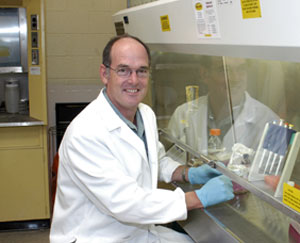Richard D. Oberst
 Professor of Diagnostic Medicine, and Director, Molecular Diagnostic Lab in the Kansas State Veterinary Diagnostic Laboratory
Professor of Diagnostic Medicine, and Director, Molecular Diagnostic Lab in the Kansas State Veterinary Diagnostic Laboratory
DVM, 1983 Oklahoma State University
PhD, 1987, University of California - Davis
Phone: (785)532-4411
Email: oberst@vet.k-state.edu
Service
As the director of the Molecular Diagnostic Laboratories (MDL) in the Kansas State Veterinary Diagnostic Laboratory (KSVDL), I oversee the molecular diagnostic services that the KSVDL offers its clientele. I directly supervise 5 staff personnel (4.5 FTE) in the MDL. The MDL at the KSVDL offers polymerase chain reaction (PCR) testing capabilities for many bacterial and viral targets using traditional PCR methods, real-time PCR methods, multiplex assays, and have recently began to offer a species specific panel, i.e., bovine respiratory panel that targets 7 viral targets and Mycoplasma bovis. The MDL has been a participant in the National Animal Health Laboratory Network (NAHLN) and involved in screening surveillance testing for selected high impact disease agents, and foreign animal diseases using real-time PCR methodologies. Our involvement in the NAHLN has allowed the lab to be a leader in developing and validating high throughput real-time PCR procedures in collaboration with other NAHLN labs and USDA, and in developing and leading individual hands-on training programs for personnel in other NAHLN laboratories across the USA to operate and complete high throughput real-time PCR procedures.
Research
The goal of my research is to develop and validate automated, user-friendly, high-throughput nucleic acid-based detection systems for veterinary diagnostic, environmental and food safety applications. I believe this process will require interdisciplinary collaboration and partnering. Currently funded collaborations include: National Animal Health Laboratory Network/USDA APHIS; Applied Biosystems/Life Technologies; US Army’s Natick Soldier Systems Center.
Instruction
I am the course coordinator for the Veterinary Virology (DMP722) course offered in the second year of the veterinary medical curriculum at Kansas State University. I also give a lecture every three weeks on current and future molecular diagnostics applications/trends to the fourth year students in the necropsy rotation (DMP785).
Patents
Patent (US & worldwide) issued on September 27, 1994 and assigned Patent No. 5,350,672. Entitled: Specific DNA primers and method to use same to detect Eperythrozoon suis.
Patent (US & worldwide) issued on June 13, 1995 and assigned Patent No. 5,424,189. Entitled: Bovine respiratory syncytial virus detection and primers.
Patent (US & worldwide) issued on July 31, 2001 and assigned Patent No. 6,268,143 B1. Entitled: Automated High Throughput E. coli O157:H7 PCR Detection System and Uses Thereof.
Recent Peer Reviewed Publications
JS Nickell, BJ White, RL Larson, DG Renter, J Roque, R Hesse, R Oberst, L Peddireddi, G Anderson. 2010. Onset and duration of transient infections among antibody-diverse beef calves exposed to a bovine diarrhea virus type 1b persistently infected calf. International Journal of Applied Research in Veterinary Medicine. In Press for publication in December, 2010, Vol 8 Issue 4.
W Ma, R Oberst, X Li, D Clouser, R Hesse, R Rowland, JA Richt. 2010. Rapid detection of the pandemic 2009 H1N1 virus M gene by real-time and gel-based RT-PCR assays. Influenza and other Respiratory Viruses. 4:397-403.
Horlen, K. P., S. S. Dritz, J. C. Nietfeld, S. C. Henry, R. A. Hesse, R. Oberst, M. Hays, J. Anderson, and R. R. R. Rowland. 2008. A field evaluation of pig mortality and growth performance following commercial vaccination against Porcine Circovirus Type 2. JAVMA. 232(6):906-912.
Fox, JT, M Corrigan, JS Drouillard, X Shi, RD Oberst, TG Nagaraja. 2007. Effects of concentrate level of diet and pen configuration on prevalence of Escherichia coli O157 in finishing goats. Small Ruminant Research 72:45–50.
Christopher-Hennings, J, M Dammen, E Nelson, R Rowland, R Oberst. 2006. Comparison of RNA extraction methods for the detection of porcine reproductive and respiratory syndrome virus from boar semen. Journal of Virological Methods 136:248-253.